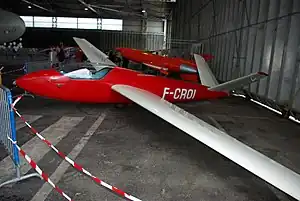Fouga CM.8
The Fouga CM.8 or Castel-Mauboussin CM.8 was a French sailplane of the 1950s, most notable in retrospect due to its place in the development of the Fouga CM.170 Magister jet trainer.
| CM.8 | |
|---|---|
 | |
| Role | High-performance sailplane |
| Manufacturer | Fouga |
| First flight | June 1949 |
| Variants | Fouga CM.88 Gemeaux |
Design and development
The CM.8 was a single-seat aircraft of conventional sailplane design and designed for aerobatics. Two prototypes were built: the CM.8/13, with a 13-metre wingspan and a conventional empennage, and the CM.8/15 with a 15-metre wingspan and a V-tail.
The pleasing performance of these aircraft led to experiments with mounting a small turbojet on the dorsal fuselage, exhausting between the tail fins. The first of these flew on 14 July 1949, powered by a Turbomeca Piméné. Designated the CM.8R this combined the 13-metre wing of the CM.8/13 with the tail of the CM.8/15. Two examples were built, and as experiments progressed in the 1950s, they were fitted with increasingly powerful engines, and increasingly shorter wingspans. A twin-fuselage example was also built as the CM.88 as an engine testbed.
Variants
- Fouga CM.8
- Fouga CM.8 Acro
- Fouga CM.8/13
- Fouga CM.8/15
- Fouga CM.8/13 Sylphe démotorisé
- Fouga CM.8 R13 Cyclone
- Fouga CM.8 R13 Sylphe II
- Fouga CM.8 R13 Sylphe III
- Fouga CM.8 R9.8 Cyclope I
- Fouga CM.8 R9.8 Cyclope II
- Fouga CM.8 R8.3 Midget
- Version intended for air racing, powered by 264 lbf (1.17 kN) Turbomeca Palas engine, with fuselage of Cyclope, and wings of reduced span (7.07 m (23 feet 2 inches)) and area 8.3 m2 (89 sq ft).[1][2] Small production series (eight[1] – twelve[3]) built.[1][2]
Specifications (CM.8/13)
Data from Jane's All the World's Aircraft 1951–52[4]
General characteristics
- Crew: One pilot
- Length: 6.55 m (21 ft 6 in)
- Wingspan: 13.00 m (42 ft 8 in)
- Height: 1.95 m (6 ft 5 in)
- Wing area: 13.0 m2 (140 sq ft)
- Aspect ratio: 13:1
- Empty weight: 247 kg (545 lb) [5]
- Gross weight: 330 kg (728 lb)
Performance
- Never exceed speed: 275 km/h (171 mph, 148 kn)
- Rate of sink: 1.22 m/s (240 ft/min)
References
- de Narbonne 2012, p. 78.
- Bridgman 1952, pp. 117–118.
- Bridgman 1952, p. 117.
- Bridgman 1951, p. 125c.
- de Narbonne 2009, p. 78.
Bibliography
- Bridgman, Leonard (1951). Jane's All The World's Aircraft 1951–52. London: Sampson Low, Marston & Company, Ltd.
- Bridgman, Leonard (1952). Jane's All The World's Aircraft 1952–53. London: Sampson Low, Marston & Company, Ltd.
- de Narbonne, Roland (June 2009). "Juin 1949, dans l'aéronautique française: Des graines d'avenir : la bonne et la mauvaise". Le Fana de l'Aviation (in French). No. 475. p. 77–79.
- de Narbonne, Roland (May 2012). "Mai 1952, dans l'aéronautique française: Le Fouga "Midjet" qui resta sur la ligne de départ". Le Fana de l'Aviation (in French). No. 510. p. 78.
- Taylor, Michael J. H. (1989). Jane's Encyclopedia of Aviation. London: Studio Editions. p. 239.
- Planeurs et Avions